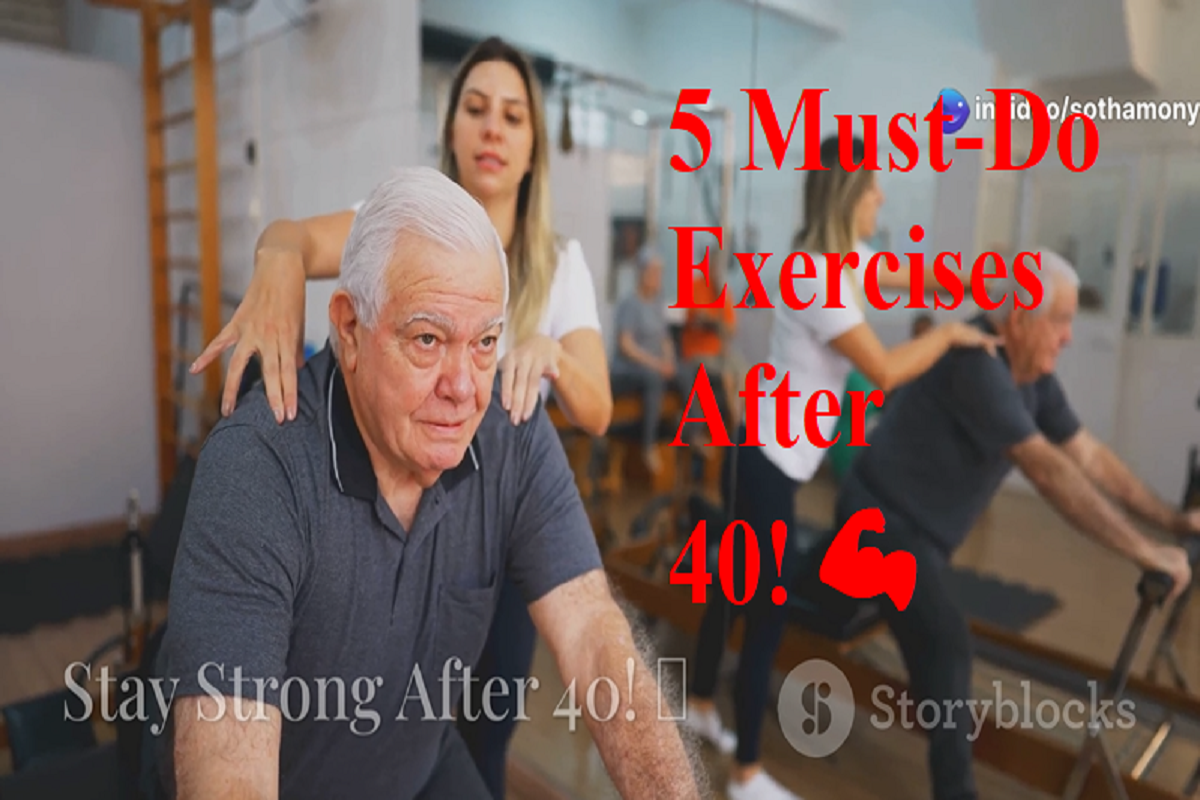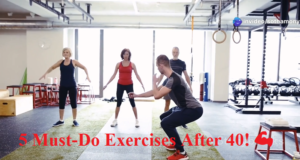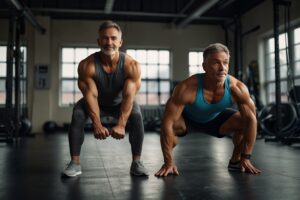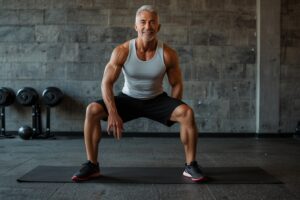As we age, staying active becomes even more critical. After 40, muscle mass naturally begins to decline, joint stiffness increases, and metabolism slows down. However, the right exercise routine can help maintain strength, mobility, and overall health. Instead of doing complicated or high-impact workouts, focusing on fundamental functional movements can help you stay strong and injury-free.
If you want to stay fit and active for decades to come, here are the ONLY 5 exercises you need to do after age 40—simple yet powerful movements that will keep you feeling your best.
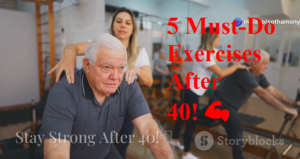
1. Squats – The Foundation of Strength & Mobility
Squats are one of the most important movements you can do to maintain lower body strength and functionality. They mimic everyday activities like standing up from a chair or picking something up from the floor. By doing squats regularly, you improve leg strength, balance, and mobility—key factors in staying independent as you age.
Why Squats Matter After 40:
- Prevents muscle loss (sarcopenia) in the legs.
- Improves mobility and flexibility in the hips and knees.
- Enhances balance, reducing the risk of falls and injuries.
- Strengthens the core, helping with posture and lower back support.
How to Perform a Proper Squat:
- Stand with feet shoulder-width apart.
- Keep your chest up and engage your core.
- Lower your body as if sitting into a chair, keeping knees aligned with toes.
- Go as low as comfortable, ideally until thighs are parallel to the ground.
- Push through your heels to return to standing.
Variations: Bodyweight squats, goblet squats (holding a dumbbell), or Bulgarian split squats.
2. Deadlifts – The Ultimate Full-Body Strength Exercise
Deadlifts are an essential exercise that strengthens the entire posterior chain (lower back, glutes, hamstrings, and core). They improve posture, support daily activities, and prevent lower back pain—one of the most common complaints after 40.
Why Deadlifts Are Essential After 40:
- Strengthens the lower back and core, preventing back pain.
- Improves posture by reinforcing posterior chain muscles.
- Increases grip strength, which tends to decline with age.
- Builds total-body strength with a simple, natural movement.
How to Perform a Safe Deadlift:
- Stand with feet hip-width apart, holding a dumbbell or kettlebell in front of you.
- Hinge at the hips, keeping your back straight as you lower the weight toward the ground.
- Keep knees slightly bent and avoid rounding your back.
- Engage your glutes and push through your heels to return to standing.
Variations: Dumbbell deadlifts, kettlebell deadlifts, Romanian deadlifts (focus on hamstrings).
3. Push-Ups – The Best Upper Body Strength Builder
Push-ups are a simple yet powerful way to maintain upper body strength, improve endurance, and engage the core. After 40, keeping your chest, shoulders, and arms strong is crucial for daily activities like pushing doors open, lifting groceries, or carrying kids or grandkids.
Why Push-Ups Are Key After 40:
- Strengthens the chest, shoulders, and triceps.
- Improves core stability, reducing back strain.
- Requires no equipment and can be done anywhere.
- Enhances shoulder mobility and function.
How to Perform a Proper Push-Up:
- Start in a high plank position with hands shoulder-width apart.
- Keep your body in a straight line from head to heels.
- Lower your chest toward the floor, keeping elbows at a 45-degree angle.
- Push back up to the starting position without arching your back.
Modifications: Knee push-ups, incline push-ups (hands on a bench), or weighted push-ups.
4. Rows (Dumbbell or Resistance Band) – Essential for Posture & Back Strength
After 40, many people develop poor posture due to prolonged sitting and weak upper back muscles. Rows are excellent for strengthening the back, counteracting slouching, and reducing neck and shoulder pain.
Why Rows Are a Must After 40:
- Strengthens the upper back, reducing back pain.
- Improves posture and prevents rounded shoulders.
- Enhances pulling strength for daily activities.
- Helps maintain spinal stability and mobility.
How to Perform a Dumbbell Row:
- Hold a dumbbell in each hand and slightly bend at the hips.
- Keep your back flat and engage your core.
- Pull the dumbbells toward your torso, squeezing your shoulder blades together.
- Lower back down slowly and repeat.
Alternatives: Resistance band rows, barbell rows, or seated cable rows.
5. Planks – The Core Stability King
A strong core is the foundation of all movement and helps prevent injuries, especially as we age. Planks are one of the best exercises for building core strength, improving posture, and reducing back pain.
Why Planks Are Essential After 40:
- Strengthens deep core muscles, protecting the spine.
- Improves posture and reduces lower back pain.
- Enhances overall balance and stability.
- Engages multiple muscle groups, improving overall strength.
How to Perform a Basic Forearm Plank:
- Lie face down and prop yourself up on your forearms.
- Keep your body in a straight line from head to heels.
- Engage your core and avoid sagging or arching.
- Hold for 20-60 seconds, gradually increasing over time.
Variations: Side plank, plank with arm/leg lifts, or dynamic planks (shoulder taps, knee drives).
Final Tips for Exercising After 40
- Prioritize Form Over Heavy Weights: Proper technique is crucial to prevent injuries.
- Incorporate Mobility & Flexibility Work: Stretching, yoga, or dynamic warm-ups will keep your joints healthy.
- Stay Consistent: Aim for at least 3-4 days per week of strength training.
- Listen to Your Body: If something feels off, modify the movement or take a rest.
- Add Walking or Cardio: A mix of strength training and moderate cardio is ideal for heart health and endurance.
Conclusion
Aging doesn’t mean slowing down—it means training smarter! These five exercises—Squats, Deadlifts, Push-Ups, Rows, and Planks—are all you need to maintain strength, mobility, and independence well into your later years. By focusing on these functional movements, you’ll build a strong foundation for an active and pain-free lifestyle.
The key is consistency and proper technique—stick to these exercises, and your body will thank you for years to come.
So, what are you waiting for? Get started today and stay strong after 40! 💪
